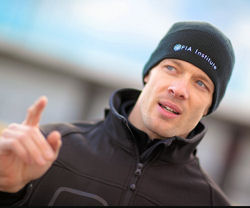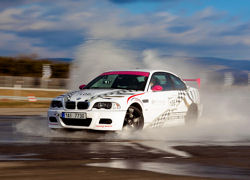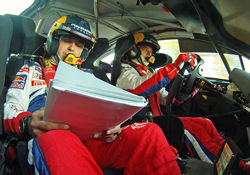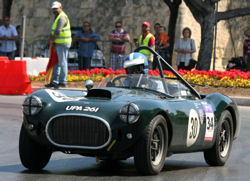
 Alex Wurz, Performance Manager, FIA Institute Young Driver Excellence Academy
Alex Wurz, Performance Manager, FIA Institute Young Driver Excellence AcademyThe 18 drivers participating in the three-day shoot-out for a place on the inaugural FIA Institute Young Driver Excellence Academy were put through their paces on the track, at the gym and in the classroom today.
Shortly after eight o’clock this morning, in the town of Melk, Austria, the race-spec BMW M3s were fired up for the first time, the track ahead of them doused with water and the first group of drivers sent out to control close to 350 horsepower on a surface shorn of grip. The shoot-out for the 10 Academy places had begun.
A Testing Day
The driving elements of the day included an examination of various skills behind the wheel. Reaction times were tested by hitting a kick-plate at 70kph, which pitched the car into a slide that first had to be gathered and then controlled as the drivers avoided obstacles in the skid area.
 If the driving tests had provided the pleasure, the gym certainly produced the pain. Participants were put through a mixture of exercises to test muscle strength and endurance for the key areas associated with high performance motor sport athletes. This culminated with the beep test, an assessment of endurance which involves running continuously between two points before the sound of the next beep that speeds up over a series of levels.
If the driving tests had provided the pleasure, the gym certainly produced the pain. Participants were put through a mixture of exercises to test muscle strength and endurance for the key areas associated with high performance motor sport athletes. This culminated with the beep test, an assessment of endurance which involves running continuously between two points before the sound of the next beep that speeds up over a series of levels.Intelligence, common sense and the ability to multi-task came to the fore in the classroom, where the 18 drivers were set a variety of team assignments, including producing a paper aeroplane capable of flying 10 metres; solving equations for fuel loads; tying a bowline knot and answering complex questions. In total, there were nine separate activities with varying levels of points on offer for each, forcing the teams to consider time-management as well as problem-solving.
Alex Wurz, Performance Manager, FIA Institute Academy, said:
“Today has been really interesting. We have seen the drivers demonstrate their skills in the cars and their impressive levels of fitness. The next stage of the assessment will be seeing how they improve and how they cope with somebody being better and somebody being worse than them on day two. The drivers are at different stages of development in their personalities – you’d expect that when we have drivers from age 17 to 23 – but this shoot-out is all about demonstrating potential as well as the ability to learn and improve.”
Richard Woods, Director General, FIA Institute, said:
“Today has been a great way to start the inaugural FIA Institute Young Driver Excellence Academy. The 18 drivers have all shown themselves to be very strong and competent in various areas, but this is just day one of what’s going to be an extremely tough process. What we’re looking for tomorrow is improvement on today, that’s the key to this shoot-out – we want an insight into each driver’s potential before we commit a valuable Academy place to them.”

Kevin Abbring (21, Netherlands)
Molly Taylor (22, Australia)
Q: Why did you apply for the FIA Institute Young Driver Excellence Academy?
Molly Taylor (MT): I came over to the UK to throw everything I had into a motor sport career and an opportunity like this, to be part of a new initiative with the FIA Institute is great. I don’t have a huge budget, so to have the potential to have access to people with so much experience is a fantastic way to try and further my career.
Q: What did you get out of today and what do you think of the Academy so far?
MT: A lot, actually. It’s always good to be put in these environments, surrounded by so many competitive people; to be really thrown in at the deep end. For me, I’m very overwhelmed by the company that I’m in, so it’s easy to feel a bit intimidated by that, but you can learn a lot from those people. You have to perform under pressure and that’s everything you do on the stage in a rally.
Q: What does the future hold for you?
MT: My goal is to be in the World Rally Championship. When I came to the UK I started a five-year plan and this is year three. Getting experience of the WRC is important for this year and then progress through the ranks to get to year five and be in the Super 2000 WRC or the Production Car WRC with plenty of experience.

